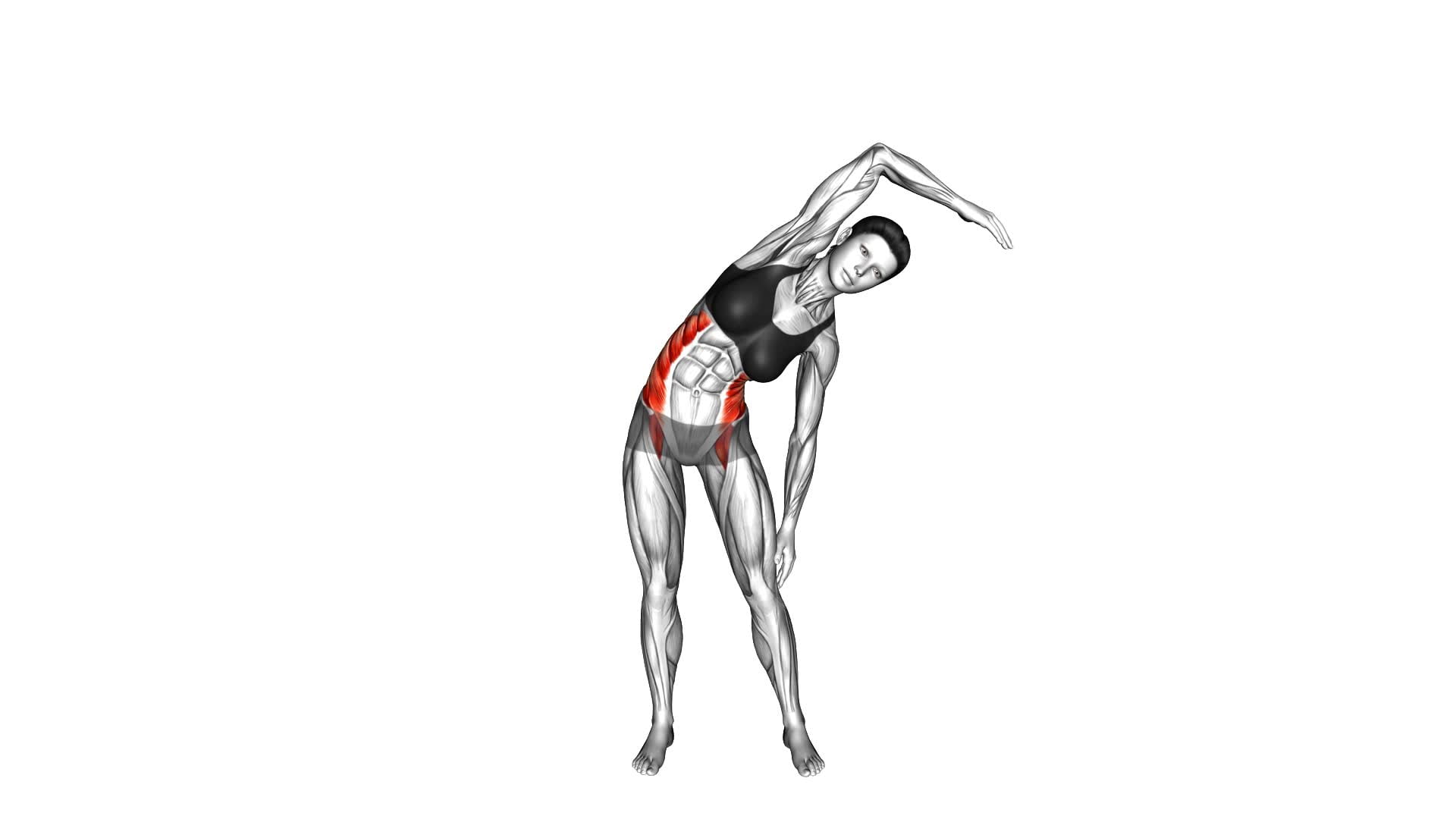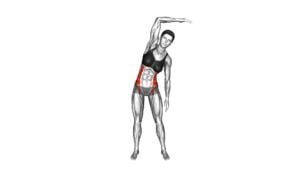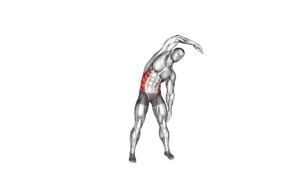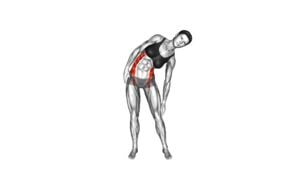Standing Side Bend (Bent Arm) (Female) – Video Exercise Guide & Tips

Incorporate the standing side bend (bent arm) into your workout routine for a targeted, effective exercise.
Watch This Exercise Video
This video exercise guide provides step-by-step instructions and helpful tips specifically for females.
Learn the proper form and technique to maximize the benefits, and discover modifications and progressions to challenge yourself further.
Avoid common mistakes and get the most out of this exercise with expert advice.
Take your fitness to the next level with the standing side bend (bent arm) – start today!
Key Takeaways
- Engages more muscles than seated side bend
- Promotes greater flexibility
- Targets obliques for a defined waistline
- Improves overall core stability
Benefits of Standing Side Bend (Bent Arm) for Females
There are three key benefits that you can experience as a female when performing the standing side bend (bent arm) exercise. This exercise offers advantages over the seated side bend (straight arm) variation, as it engages more muscles and promotes greater flexibility.
The standing side bend (bent arm) exercise targets the obliques, the muscles on the sides of your waist. By bending to the side while holding a weight or resistance band, you activate these muscles and strengthen them. This helps to create a more defined waistline and improves overall core stability.
Additionally, the standing position allows for a greater range of motion compared to the seated side bend. You can fully elongate your body, stretching the muscles along your sides, which promotes flexibility and prevents tightness.
To maximize the benefits of the standing side bend (bent arm) exercise, it's crucial to incorporate stretching into your routine. Before starting the exercise, take a few minutes to stretch your obliques and other core muscles. This will prepare your body for the movement and help prevent any potential injuries.
Proper Form and Technique for Standing Side Bend (Bent Arm)
To perform the standing side bend (bent arm) exercise with proper form and technique, you should follow these guidelines:
- Stand with your feet hip-width apart and engage your core muscles to stabilize your body.
- Begin by bending your right arm at the elbow, placing your hand behind your head with your fingers lightly touching the back of your head.
- Slowly bend your torso to the left, keeping your chest lifted and your shoulder blades drawn down and back.
- Feel the stretch along the right side of your body as you lean to the left, but be careful not to hunch your shoulders or strain your neck.
- Hold the stretch for a few seconds, then return to the starting position with control.
- Repeat the exercise on the opposite side, bending your left arm and leaning to the right.
- Remember to breathe deeply throughout the movement to enhance relaxation and flexibility.
The standing side bend (bent arm) exercise offers several benefits for men, including improved flexibility and mobility in the side body, strengthened core muscles, and increased overall body coordination. Additionally, this exercise can be modified to suit different fitness levels by adjusting the range of motion or using light dumbbells for added resistance.
Common Mistakes to Avoid During Standing Side Bend (Bent Arm)
Avoid these common mistakes when performing the standing side bend (bent arm) exercise to ensure proper technique and maximize your results.
One common mistake is using too much weight or resistance. It's important to start with a lighter weight and gradually increase as you become more comfortable and confident with the exercise. Using too much weight can lead to improper form and potential injury.
Another mistake is bending forward instead of to the side. Maintain a straight posture throughout the exercise and focus on bending to the side, not forward.
Additionally, avoid locking your knees and elbows. Keep a slight bend in your knees and elbows to engage your muscles and protect your joints.
Lastly, avoid jerky or fast movements. Slow and controlled movements are key to effectively target your side muscles.
By avoiding these common mistakes, you can perform the standing side bend (bent arm) exercise with proper technique and reduce the risk of injury.
Now, let's move on to the next section to learn about modifications and progressions for this exercise.
Modifications and Progressions for Standing Side Bend (Bent Arm)
To modify or progress the standing side bend (bent arm) exercise, try incorporating different variations or increasing the weight or resistance. Here are some modifications for advanced practitioners and progressions for intermediate individuals:
- Increase the weight or resistance: If you find the standing side bend too easy, try using a heavier dumbbell or resistance band. This will challenge your muscles and help you progress.
- Add a twist: To further engage your obliques and increase the difficulty, you can incorporate a twist into the exercise. As you bend to the side, rotate your torso towards the ceiling. This will target your core muscles even more.
- Perform the exercise on an unstable surface: If you want to take your standing side bend to the next level, try performing it on an unstable surface such as a Bosu ball or a wobble board. This will challenge your balance and stability, making the exercise more intense.
Remember to always maintain proper form and listen to your body. It's important to push yourself, but not to the point of pain or discomfort. Modify or progress the exercise based on your fitness level and goals.
Tips for Getting the Most Out of Standing Side Bend (Bent Arm)
Maximize your results with the Standing Side Bend (Bent Arm) exercise by focusing on stability and control. To get the most out of this exercise, it's important to incorporate variations and use the right equipment.
When performing the Standing Side Bend (Bent Arm), you can vary the intensity by using different weights. Start with lighter weights to build strength and gradually increase the weight as you progress. This will challenge your muscles and help you achieve better results. Additionally, you can try using resistance bands or cables to add resistance and increase the difficulty of the exercise.
Proper equipment is also essential for maximizing your results. Make sure to use a sturdy and stable surface to stand on, such as a yoga mat or a flat floor. This will provide a solid base for your movements and prevent any unnecessary strain on your body. Moreover, using dumbbells or kettlebells with a comfortable grip will allow you to maintain control throughout the exercise.
Remember to maintain proper form and technique while performing the Standing Side Bend (Bent Arm). Engage your core muscles and keep your back straight throughout the movement. Avoid using excessive momentum and focus on controlled and deliberate movements.
Sample Workout Routine Incorporating Standing Side Bend (Bent Arm)
Now that you've learned the tips for getting the most out of the Standing Side Bend (Bent Arm) exercise, it's time to incorporate it into a sample workout routine.
Side bends are a great way to target your oblique muscles and improve your core strength. If you're a beginner, you can modify the exercise by using lighter weights or even just your body weight to start.
Benefits of Side Bends
Start by incorporating the standing side bend (bent arm) into your workout routine to experience the numerous benefits. Side bends are a great exercise that target the obliques, helping to strengthen and tone your waistline.
Here are some benefits of adding side bends to your workout routine:
- Core strength: Side bends engage your core muscles, including the obliques and abdominals, helping to improve core stability and strength.
- Improved posture: Side bends can help to correct imbalances in your posture by strengthening the muscles that support your spine.
- Increased flexibility: Performing side bends can help to increase flexibility in your side body, improving your overall range of motion.
To perform side bends correctly, stand with your feet shoulder-width apart and your knees slightly bent. Place your hand on your hip or hold a dumbbell in one hand. Slowly bend to the side, focusing on engaging your core and keeping your shoulders and hips aligned. Return to the starting position and repeat on the other side.
Modifications for Beginners
To modify the standing side bend (bent arm) exercise for beginners, focus on engaging your core and maintaining proper alignment throughout the movement. This will help you build a strong foundation and prevent injury.
One beginner modification is to start with a smaller range of motion, gradually increasing it as you gain strength and flexibility. You can also use a lighter weight or no weight at all to reduce the intensity.
Another modified variation is to perform the exercise seated on a chair or stability ball, which provides additional support and stability.
Remember to listen to your body and only push yourself as far as feels comfortable. With consistent practice, you'll gradually progress and be able to perform the full standing side bend (bent arm) exercise.
Frequently Asked Questions
Can Men Also Perform the Standing Side Bend (Bent Arm) Exercise?
Yes, men can definitely perform the standing side bend (bent arm) exercise. It's a great exercise for men's fitness as it targets the oblique muscles and improves core strength.
However, if you're looking for alternative exercises, you can try side planks, Russian twists, or bicycle crunches. These exercises also work the obliques and provide a good challenge for your core muscles.
Remember to maintain proper form and consult with a fitness professional if needed.
How Many Sets and Repetitions Should I Do for the Standing Side Bend (Bent Arm) Exercise?
To modify the standing side bend (bent arm) exercise for beginners, start with lighter weights and focus on proper form. Gradually increase the weight as you become more comfortable and confident.
As for sets and repetitions, aim for 2-3 sets of 10-12 repetitions on each side.
This exercise helps strengthen and tone your oblique muscles, improving core stability and posture. Incorporating the standing side bend into your workout routine can bring variety and target specific areas of your midsection.
Can I Use Weights or Resistance Bands to Make the Standing Side Bend (Bent Arm) Exercise More Challenging?
Yes, you can definitely use weights or resistance bands to make the standing side bend exercise more challenging. By incorporating dumbbells or resistance bands into the exercise, you add an extra level of resistance that will engage your muscles even more.
This variation of the standing side bend can help strengthen your core stability and increase the overall intensity of the workout.
Is It Necessary to Warm up Before Performing the Standing Side Bend (Bent Arm) Exercise?
Before performing the standing side bend exercise, it's essential to warm up. Warming up helps increase blood flow to your muscles, making them more flexible and ready for exercise. It also reduces the risk of injury.
To warm up, you can do some light cardio exercises or dynamic stretches.
When doing the standing side bend, remember to avoid common mistakes like using momentum or hunching your shoulders. Focus on maintaining proper form and engage your core for maximum benefits.
Are There Any Specific Breathing Techniques I Should Follow During the Standing Side Bend (Bent Arm) Exercise?
During the standing side bend (bent arm) exercise, it's important to focus on your breathing techniques. Take a deep breath in as you bend to the side, and exhale as you return to the starting position. This helps engage your core and maintain control throughout the movement.
Avoid holding your breath or breathing rapidly. Also, be mindful of common mistakes like leaning forward or arching your back. Keep your body aligned and maintain proper form for maximum effectiveness.
Conclusion
In conclusion, the standing side bend (bent arm) exercise is a great way for females to strengthen their core and improve their posture. By following the proper form and technique, avoiding common mistakes, and making modifications or progressions as needed, you can get the most out of this exercise.
Incorporating it into your workout routine will help you achieve a stronger and more balanced physique. So give it a try and enjoy the benefits of the standing side bend (bent arm) exercise!

Author
Years ago, the spark of my life’s passion ignited in my mind the moment I stepped into the local gym for the first time. The inaugural bead of perspiration, the initial endeavor, the very first surge of endorphins, and a sense of pride that washed over me post-workout marked the beginning of my deep-seated interest in strength sports, fitness, and sports nutrition. This very curiosity blossomed rapidly into a profound fascination, propelling me to earn a Master’s degree in Physical Education from the Academy of Physical Education in Krakow, followed by a Sports Manager diploma from the Jagiellonian University. My journey of growth led me to gain more specialized qualifications, such as being a certified personal trainer with a focus on sports dietetics, a lifeguard, and an instructor for wellness and corrective gymnastics. Theoretical knowledge paired seamlessly with practical experience, reinforcing my belief that the transformation of individuals under my guidance was also a reflection of my personal growth. This belief holds true even today. Each day, I strive to push the boundaries and explore new realms. These realms gently elevate me to greater heights. The unique combination of passion for my field and the continuous quest for growth fuels my drive to break new ground.







